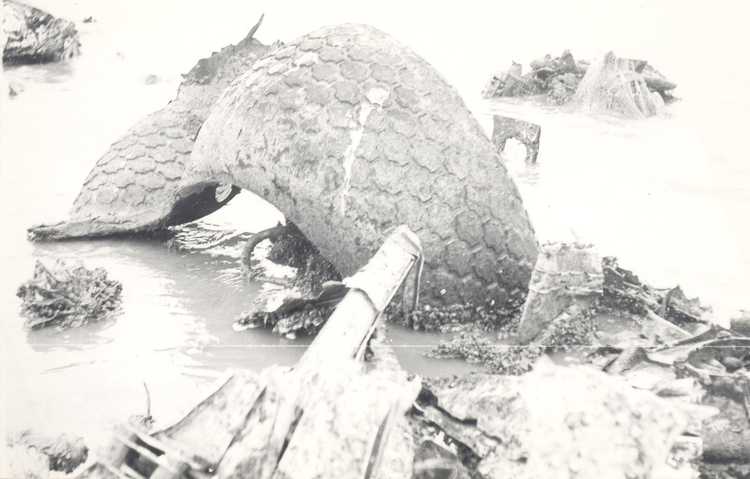How did it happen? As the aircrafts crashed from the skies you could hear the engines howl and then in a split second it all went quiet. As boys we always went to look, it interested us so that’s what we did. I went to a field, a few days after an aircraft had crashed and it was just all small bits and pieces. There were even body parts lying there. I remember finding a 'Pilots Wing'' there with RAAF on it. Back in 1943, but at the time I did not know that it meant Royal Australian Air Force.
The aircraft was totally disintegrated. Later, when I began my salvage work, we also found German 'crashreports' and in the German crashreport on the above mentionend aircraft was said 'remains of 7 men in one coffin'. This meant that on crash she had been smashed to smithereens. You wouldn’t find anything anymore there.
These men are buried in what is called a 'collective grave'. Any remains that have been found, are buried there. Their names engraved on the grave stone. Some people still believe there must be something left at the scene of the crash but when they go and look, they find nothing. Not surprisingly, but they do not know anything anymore about these circumstances of war. I've seen it in Harlingen, the aircraft (a B-17) came due to battle damage in trouble over the Waddensea (old Zuyersea) but crashed on land. Three men of the crew baled out already over sea, but the two survivors waited untill the aircraft came back over land again before baling out and came down on land. The three who baled out over sea had no change at all, with a strong eastern wind theydrifted out further over sea but in the cold winterweather (December 1943) would not have a single change after getting down. Against German orders the Harlingen lifeboat sailed to search for them, but had no luck and came back to the harbour without them. Those three boys are still “missing” today but will never be found again, most certainly not at the crashplace of the aircraft.
Childhood memories
Was the war was an exciting time? In a way it was a bit. I was twelve when the war began. Old enough to remember what happened but still young enough to roam around here and there. You entertained yourself. Moreover, we lived in Harlingen, a port city. They fished in Harlingen. The German Navy was also in port. They (confiscated) stole a lot of our fishing boats, but oddly enough, just your average German sailor was on board, not your typical Nazi soldier. I saw it all myself, and I've allso seen bodies washing ashore. Things like that attracted us.
I remember in 1934, when I was six, we were out in The Hague. I was allowed to stay up in the evening because a aircraft would be flying over and I could see the lights. Ten years later, there were two thousand aircraft flying overhead on a daily basis!
Civilians were constantly involved, as the airwar was that part of the war they were directly confronted and connected with. They saw air combat , and see aircraft crashing. I saw several aircombats myself.
Walking on a dark winter evening you could hear the aircrafts, the night fighters, their tracer... you saw the aircrafts catch fire, burning pieces flying to the ground ... You saw aircrafts crash into the sea. And you couldn’t do anything about it. That’s the way it went in those days. The Netherlands was full of night fighters. Leeuwarden, Gilze-Rijen, Twente and Venlo, these were the four night fighter fields.
He couldn't be there, he didn't have the range
We were skating in February 1941. We skated from Harlingen to Bolsward, from Bolsward to Makkum and from Makkum back to Harlingen. It was the afternoon of Saturday the 8 th , as Saturday morning we had to go to school. I was thirteen. We had just passed Bolsward on our way to Makkum and we heard a plane. It was lousy weather, drizzly. We thought how could you be flying in this weather? We saw him, it was an English fighter, I recognized the type, a Hurricane. If I close my eyes, I can still see him. So very low. He waved, we waved. Something very special. We talked about this for months. After the war I went to investigate. A British friend of mine said:
"Gerry, he couldn’t have been there. He didn’t have the range. He couldn’t have flown so far."
He had been chasing a German aircraft from England and lost his way due to bad weather. Above Friesland he was back on a west course towards England but he didn’t have enough fuel. Halfway over the North Sea, he transmitted that he couldn’t make it. He is still missing. (He was F/O. Laurie Cryderman, a Canadian Battle of Britain pilot, one of the last things he did, was wave to some Frisian boys.!) If you have seen and experienced it, it’s something you will always remember, for the rest of your life. That’s one of the reasons I started working on air warfare . It started with research around Harlingen, and later on the whole Netherlands. When I joined the Air Force as a salvage chief in 1967 I was fairly well informed on the airwar subject.
